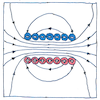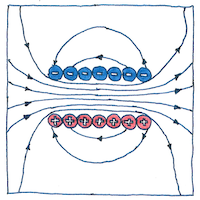Hans Christian Ørsted,
André-Marie Ampère,
Michael Faraday
electromagnetism

|
Electromagnetism
Small particles act together as a wave. Singly, sent through a slit one by one, each contributes to a beautiful pattern. Scientists Ørsted, Ampère, Faraday— Danish, French, British— —noticed a compass needle deflected near a wire carrying a current, the first discovery of the relationship between electricity and magnetism —found that two electric wires magnetically attract when the currents flow in the same direction and created the first galvanometer to measure the flow of electricity —demonstrated the first electric motor, created the first electric transformer and the first electric generator
Secret agent
One person may have power over another. A conspiracy may control our lives with patterns of radio pulses. Aliens may have invisible means to interpret our dreams and control our desires. Surely many of us cannot control our own desires and may believe ourselves susceptible especially when we cannot admit to ourselves the motives we wish to hide. Naturally, we must be circumspect. These very motives, like the secret agent’s vice, may put us under the power of malicious forces, forces that some may claim will save the world.
Penetrations
Many waves pass through us as though we were mostly air. Millions of lost electrons fly like gnats through the great spaces inside us. Radio waves, microwaves, shortwaves, longwaves, leakage from generators, transformers, power lines, cathode rays, X-rays, gamma rays, cosmic rays penetrate us silently. Space, or air, or seeming solidity, is no impediment. We cannot protect ourselves against their irresistible forces.



The development of the field of electromagnetism is a good example of how scientists extend each others’ work, even working in different countries.
The strong interaction, the weak interaction, gravitation, and electromagnetism are the four fundamental interactions in nature. So many modern devices depend on electromagnetism (such as the telephone, radio, computers, wireless communications), but, even more profoundly, without electromagnetism there would be no light nor heat; atoms and molecules would not hold together and would not interact chemically with each other.
See also in The book of science:
Readings: